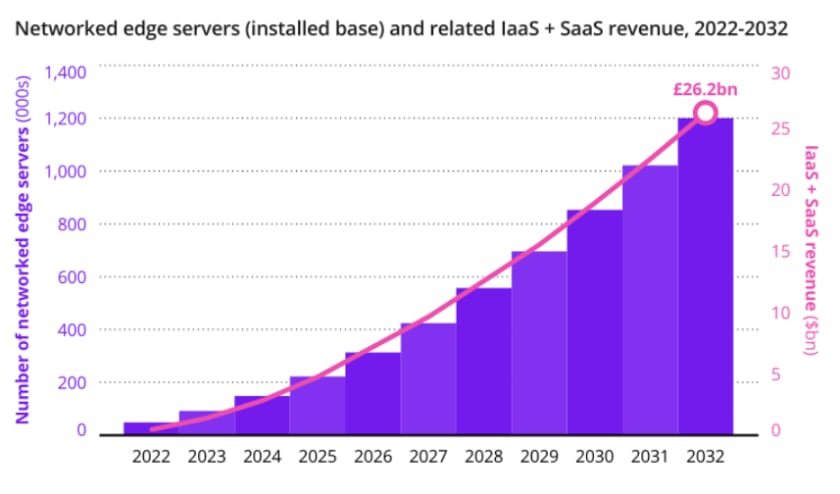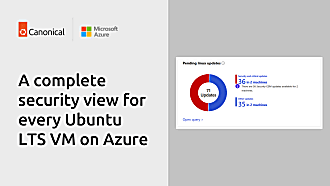Canonical
on 5 December 2024

Canonical is excited to return to the Mobile World Congress (MWC), taking place in Barcelona on March 3-6, 2025. Come and see us at Booth 2A90, Hall 2.
Next year’s event brings attendees together around a new theme: Converge. Create. Connect. This edition will delve into topics like enterprise reinvention and cover how organizations can rethink their digital strategy to gain a competitive advantage. We’ll add our voice to the mix in a uniquely open source way, bringing a host of exciting demos and conversations around next-generation infrastructure, edge computing and confidential AI.
One of the biggest opportunities we will address is the growth of 5G, driven by new edge computing and AI use cases. Let’s dive into why we’ve put this on our agenda for Mobile World Congress 2025.
The 5G edge: a $26bn opportunity awaits
Until recently, concerns about the absence of a “killer app” to drive the growth of 5G networked edge computing fueled uncertainty among Communication Service Providers (CSPs) about use cases and demand. But the tide is turning.
Our latest research report, produced in collaboration with Omdia, shows that 90% of CSPs who don’t already have a full commercial edge computing deployment in place, plan to complete it within the next two years. What’s driving action? A significant revenue opportunity.
Omdia projects the global installed base of edge servers on public networks to grow from around 100,000 in 2023 to around 1.2 million units by 2032, with the expectation that, by this time, 5G core and virtual RAN (vRAN) will have truly scaled as key enablers of new edge services and applications. The computing resources and the applications that run on them are expected to grow to an annualized revenue potential of more than $26bn (IaaS and SaaS) within the same period.
Cloud-native network transformation will be essential to monetize the edge. Establishing a common cloud eliminates the need for multiple stacks and offers a vendor agnostic layer of modularity for these next-generation networks.
Open source cloud platforms have an important role to play here. Canonical open source offers you the most cost-effective and reliable way to cloudify your network, monetize the edge and scale up your AI projects securely.
Build your cloud your way
With Canonical, your network’s core cloud is designed to give you resilience and scalability, without sacrificing flexibility. Our open source portfolio helps you break free from proprietary lock-in, giving you architecture freedom – from the operating system layer with Ubuntu to private clouds with OpenStack and containerized network functions with Kubernetes. Our infrastructure technologies also include advanced lifecycle management features that lower operational burdens, helping you minimize costs. What’s more, everything in our portfolio is covered under a single subscription for security maintenance and support, which is essential to ensure a compliant telecom infrastructure.
Leading telco vendors like BT have chosen Canonical to build their 5G network cloud to gain the best balance between cost, support and control. With a network based on Canonical OpenStack, BT Group successfully rolled out 5G access to over 75% of the UK population.
Stop by our booth to learn more >
Monetize the edge with distributed compute, optimized for resource efficiency
Canonical’s open source portfolio also enables you to deliver infrastructure for multi-access edge computing (MEC) and Open RAN. Work with us to unlock new revenue streams and accelerate 5G services innovation, including improved application delivery and premium connectivity features.
With Canonical’s open source infrastructure software portfolio, you can achieve a cost-effective and distributed Open RAN that runs on COTS hardware. This provides flexible deployments for running virtual RAN workloads across a distributed cloud.
Our close partnerships with leading silicon vendors, including AMD, ARM, Intel, NVIDIA, and Qualcomm, ensure our software is tuned for performance at the edge.
Our solutions also enable you to automate the lifecycle and reduce the complexity of managing distributed AI/ML applications, helping you take advantage of more efficient operating models.
Implement AI models at scale and securely
Speaking of efficient operating models, generative AI has immense potential to deliver value in a variety of areas for telcos, from customer service to self-healing networks. In fact, McKinsey estimates that the productivity gains from different AI use cases can amount to $140 billion to $180 billion. Ensuring the security and confidentiality of data for these use cases is essential – and Retrieval-Augmented Generation (RAG) can play a critical role in protecting your data in applications such as chatbots.
When combined with confidential AI, RAG enables you to enhance the knowledge base of your LLMs while protecting your model’s IP and data at runtime. Confidential AI is made possible by confidential computing, a new privacy-enhancing technology offered by Canonical in both public and private cloud environments running Ubuntu.
Stop by our booth to see edge AI in action and speak with our experts.
We look forward to connecting with you
We are excited to connect with you at the biggest telecom event of 2025 – pun intended. As a reminder, we’re at Booth 2A90, Hall 2. Stop by to talk to us about open source infrastructure, edge AI and the future of communications!
You are also welcome to reserve a slot to speak to us by clicking the button below.
To learn more about what we’ll be presenting at MWC, visit our dedicated MWC page.




